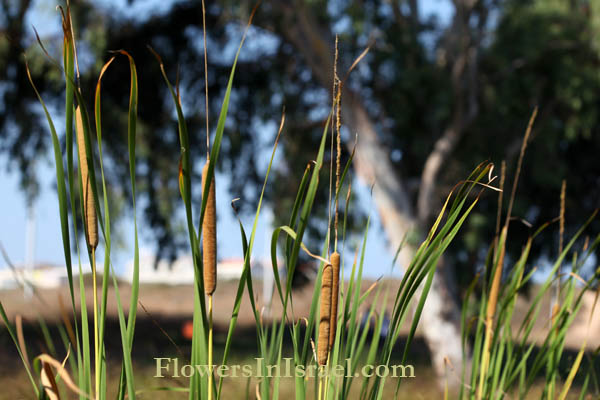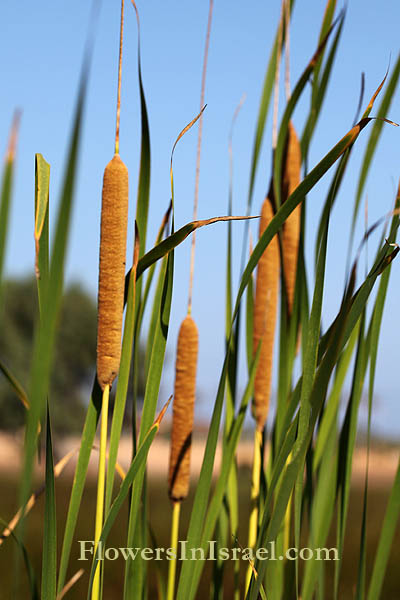Bulrush, Southern Cattail, Narrowleaf Cattail,
Hebrew: סוף מצוי, Arabic: افلح/ىدرب
| Scientific name: | Typha domingensis (Pers.) Steud. | |
| Synonym name: | Typha angustifolia Bory & Chaub., Typha australis Schum. & Thonn. | |
| Common name: | Bulrush, Southern Cattail, Narrowleaf Cattail | |
| Hebrew name: | סוף מצוי, suf | |
| Arabic name: | Halfa/Bardi, افلح/ىدرب | |
| Plant Family: | Typhaceae, סופיים |

Location: Netanya, the Dora rain pool |
| Life form: | Helophyte | |
| Stems: | To 2 m high with creeping rhizomes | |
| Leaves: | Alternate, rosette, entire | |
| Flowers: | Green; separate male (upper) and female flowers (lower) on one spike | |
| Fruits / Pods: | straw-colored, orange-spotted, apex broadly rounded; small seed, one-seeded follicle surrounded by silky hairs | |
| Flowering Period: | Summer | |
| Habitat: | Humid habitats | |
| Distribution: | Mediterranean Woodlands and Shrublands, Semi-steppe shrublands, Shrub-steppes, Deserts and extreme deserts, Montane vegetation of Mt. Hermon | |
| Chorotype: | Med - Irano-Turanian - Saharo-Arabian | |
| Summer shedding: | Perennating |

Location: Netanya, the Dora rain pool Derivation of the botanical name: Typha, typhos (Greek), "marshes", a name that has been written for these plants since Theophrastus (372-287 BCE) called them tiphe (τὐφη) and Dioscorides (40-80 CE) wrote tiphes (τυφης). ”Typha is linguistically related to Typhon, typhoon, and typhus. These words link four concepts - monsters, storms, diseases, and plants. Typhon, as the father of the Winds, causes dangerous storms. This deity’s name is cognate with “typhoon,” borrowed from the Arabic, Persian, and Urdu وافن tufân (to turn around), and still in use to describe violent cyclonic storms of the Indian Ocean. domingensis, meaning from Dominica, refer to the plants's native habitat. angustifolia, Latin angusti-, narrow; narrow-leaved. australis, southern.
as in the passage from Jonah 2:5. The word yam in Hebrew is the ordinary word for "sea," although in Hebrew it is used for any large body of water whether fresh or salt. The word suf is the word for "reeds" or "rushes," the word used in Exodus 2:3, 5 to describe where Moses' basket was placed in the Nile. So, the biblical reference throughout the Old Testament is to the "sea of reeds" (e.g., Numbers 14:25, Deuteronomy 1:40, Joshua 4:23, Psalms 106:7. etc.). In Exodus and Isaiah suf can be translated as Typha; in Egypt it was called tupai. Two species of Typha dominate in Egypt: Thypa elephantina and Thypa domingensis. Typha is used by people around the world as a source of food and household items. Jerome (Eusebius Hieronymus, 347-419), used harundine in the Hebrew to Latin translation of the Bible, the Vulgate. Harundo, the basis of harundine, can mean reed, cane, fishing rod, limed twigs for catching birds, arrow shaft, or pipe. Because of the Hebrew or Vulgate reference, the Christians of the Middle Ages began using cat-tails in artwork. Typha appears as part of the scenery in the tapestries of unicorns; both plant and animal were allusions to Christ. Paintings by Flemish artist Sir Anthony Van Dyck (1599 – 1641) of Jesus’ mock trial have him with a cat-tail in his hand as a scepter. Even Leonardo da Vinci (1452-1519), included Typha. "Of tzité the flesh of man was made, but when woman was fashioned by the Creator and the Maker, her flesh was made of rushes. These were the materials the Creator and the Maker wanted to use in making them". The Book of the People: Popol Vuh, Part I, Chapter 3 (ancient Mayan document; written between 1554 and 1558) Typha has been involved in not only secular life, but played prominent roles in people’s sacred lives. Bible Resources:
|